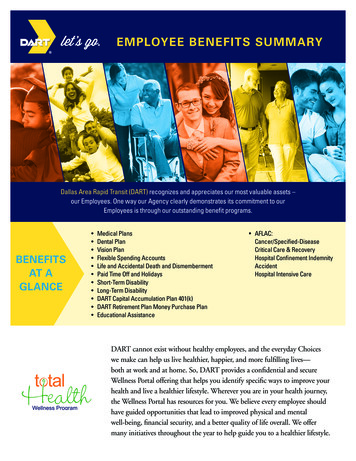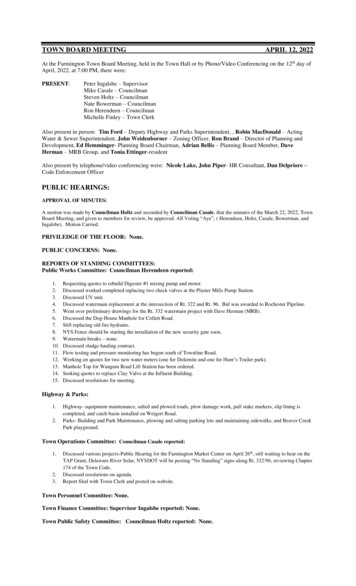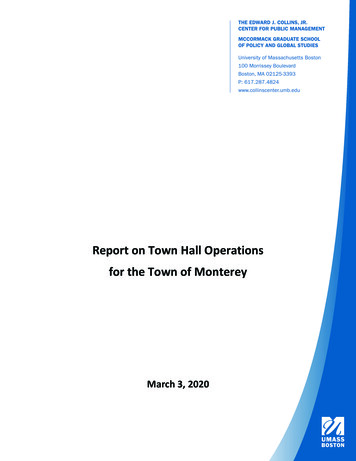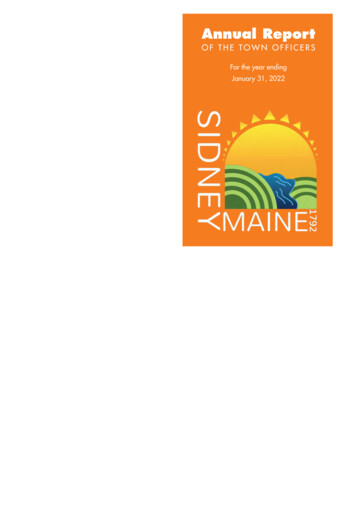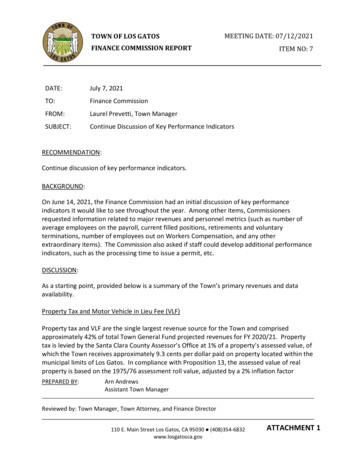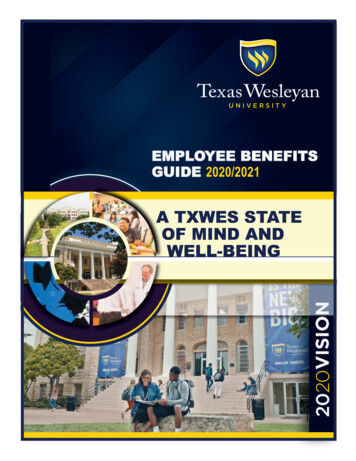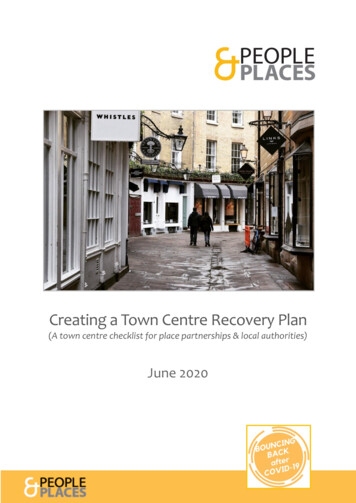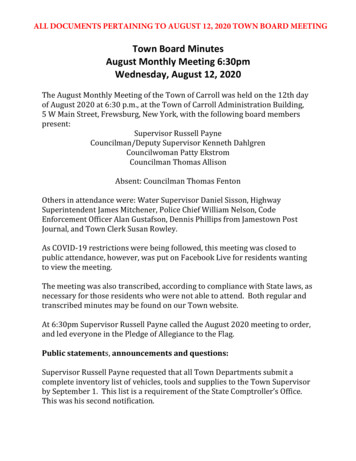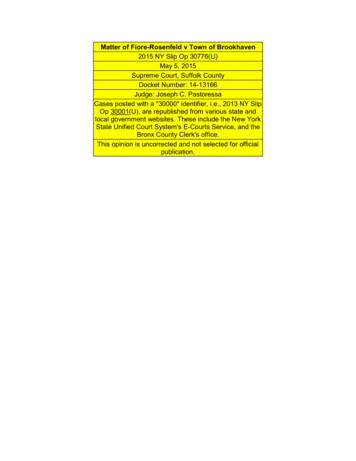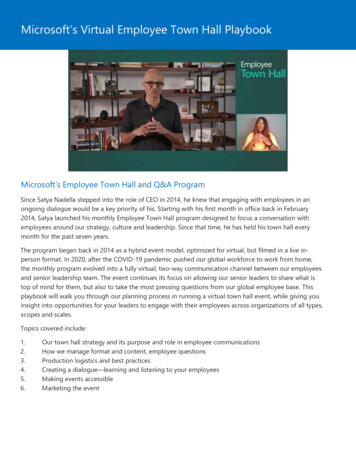
Transcription
Microsoft’s Virtual Employee Town Hall PlaybookPlaybookFebruary 2019Microsoft’s Employee Town Hall and Q&A ProgramSince Satya Nadella stepped into the role of CEO in 2014, he knew that engaging with employees in anongoing dialogue would be a key priority of his. Starting with his first month in office back in February2014, Satya launched his monthly Employee Town Hall program designed to focus a conversation withemployees around our strategy, culture and leadership. Since that time, he has held his town hall everymonth for the past seven years.The program began back in 2014 as a hybrid event model, optimized for virtual, but filmed in a live inperson format. In 2020, after the COVID-19 pandemic pushed our global workforce to work from home,the monthly program evolved into a fully virtual, two-way communication channel between our employeesand senior leadership team. The event continues its focus on allowing our senior leaders to share what istop of mind for them, but also to take the most pressing questions from our global employee base. Thisplaybook will walk you through our planning process in running a virtual town hall event, while giving youinsight into opportunities for your leaders to engage with their employees across organizations of all types,scopes and scales.Topics covered include:1.2.3.4.5.6.Our town hall strategy and its purpose and role in employee communicationsHow we manage format and content, employee questionsProduction logistics and best practicesCreating a dialogue—learning and listening to your employeesMaking events accessibleMarketing the event
StrategyMicrosoft has over 175,000 employees worldwide and identifying meaningful ways for the CEO to engagewith them was at the top of our list. The Employee Town Hall and Q&A program was one of the firstprograms put into place as the CEO team thought about how Satya would engage with the globalMicrosoft employee base.The vision for the Q&A was shaped by several principles our comms team was driving forward: Highlight the company’s cultural transformation under Satya’s leadership.o It was important to ensure the town hall reflected Microsoft’s ongoing culturaltransformation and encouraged transparency within the company. This involved creatingspace for two-way dialogue between employees and leadership, as well as including morelistening elements as opposed to top-down communications, to ensure employees feltheard.Practice what we preach when it comes to company culture.o The show has been a platform for Microsoft to truly lead by example, whether it’s by havingleaders be transparent, exhibiting growth mindset in their answers or being meticulous in allthe details of making an enjoyable, accessible viewing experience for both in-person andonline audience members.Address strategic and relevant business updates.o The town hall provides an opportunity for employees to learn and seek clarity on relevantstrategic and business updates including corporate and product news.Provide opportunity to discuss timely or societal moments in time.o In addition to Satya addressing timely events and moments in time in opening remarks,employees have an opportunity to raise questions in the Q&A segment. For example,pandemic response, D&I progress, global days/months of recognition, etc.Employees value authenticity from their leaders.o While we have several prepared topics to talk about, we allow plenty of time for employeesto ask questions in-person or real-time to Satya and other leaders. This gives leaders achance to answer questions candidly and avoids having leaders seem too tied to a script,while also showing the diversity and depth of expertise across leaders at the SLT andexecutive staff level.
We’ve been on this journey for the last seven years, and while we’re continuously optimizing andimproving our strategy, we have some good learnings, including: Making the Employee Town Hall mandatory/opt-out for the Senior Leadership Team (SLT)members versus opt-in.o SLT members are expected to attend at least 6 out of the 10 town halls held in a calendaryear. We really want to be intentional in making two-way communication a standard part ofMicrosoft culture, starting with our top leaders. Having them in the audience reinforces ourlistening culture and takes some of the accountability off Satya to answer every question.Communications from Satya, followed closely by communications from senior leadership,were voted as the most influential sources that shape employee opinions.o Leaders should meet employees where they are at—internal communication channels havebecome the most important news sources for employees, as compared to external newssources just a few years ago. We are intentional in having each Employee Town Hall serve asa platform for employees to hear from leadership on the most important news andinformation, whether it’s an internal company issue or an external news event.Ensuring diverse representation throughout the entirety of the show.o The show should have diverse and global representation throughout including: our featuredYambassador, the country selected for our Postcards in the Field segment, leaders speakingin our proactive segment as well as in the Q&A segment of the show.
Format/ContentEmployee Town Halls are held monthly, currently in an all virtual format. Events last for 45 minutes and aretypically about 50% prepared content and 50% Q&A. We ask the entire Senior Leadership Team to attend- which can be a max of 14 people depending on availability. This allows us to showcase a unifiedleadership team and to address a wider variety of questions. On average we get around 25k employeeswatching live in-person, with another 10k watching on-demand.Proactive content is selected by looking at the news agenda for the past month to determine what if any,key moments we want to highlight. In addition, the CEO team will evaluate Satya’s opening remarks todetermine what he can cover and then what we want to place in the Q&A. The result is about 7-10 minutesof opening top of mind remarks for Satya and then 1-2 proactive segments from various leaders on keymoments or hot topics. Finally, we run a standard 5 minute segment in every show called- Postcards fromthe Field – where we interview a leader from one country – highlighting our impact and work in that region.Questions are sourced in the month leading up to the event through a mix of Yammer, Daily Pulse and ananonymous survey. Questions are compiled and the best ones are selected and then pitched to the CEOand SLT comms leads for possible inclusion. We monitor Yammer during the live show as well, andpending time, will sometimes take 1-2 live questions during the show.Over the years, the importance of the virtual experience has become greater. That’s how our viewingaudience consumes these events. It’s important to optimize for the virtual, making your events engagingonline and accessible for all. For the Employee Town Hall program, we rely heavily on Yammer to make theevent engaging through moderated Q&A, online polls and employee conversation.
Pre-event: 1 Month Out: The CEO team begins prepping the Employee Town Hall agenda, giving leadersample time to coordinate any necessary speakers, identify hot/trending topics, and plan for anydemos or special occasions. We always designate a “Yambassador”, a Microsoft employee whomoderates the open Q&A portion by selecting questions from the CEO Connection Yammer page.The Yambassador is not a member of our comms team, as we try and invite a wide variety ofemployees to participate in choosing questions to cover. We look for Yambassadors who canrepresent the topic, theme or building behind that particular Q&A, or someone who is a leadingexample of Microsoft’s culture. 10 Days Out: The CEO team and employee sentiment team closely monitor Yammer and DailyPulse to source potential questions for leaders to address. 5-7 Days Out: The CEO team, working with SLT comms leads, solidifies topics to be covered andconnects with our production team to ensure that all production components are good to go. 1 Day Out: Set up for event. Rehearse run of show with production and accessibility team.During:A typical event allows about 20-25 minutes for programmed content and 20-25 minutes for Q&A. Duringthe show, the CEO team is vetting online question submissions and forwarding them to the designatedYambassador to ask live. The CEO team also starts a Teams chat with production teams during the show toensure a smooth live viewing experience, making sure live captioning works and video quality is sufficient.Post-event:Once the town hall ends, the production team immediately begins working on making the VOD (video ondemand) available online. The Employee Events team sends out a company-wide email containing links tothe most important clips. The team also updates MSW (our employee intranet portal), the Employee TownHall site, and the CEO Connection site with a link to stream the VOD. We present employee sentimentduring the Employee Town Hall in a post event report to Satya and his comms team so they have visibilityinto how employees feel about his answers to hot topics (see more on this report in “Employee Listeningand Sentiment”).
ProductionTo pivot to a virtual format, the production team uses Teams in order to bring live guests into the showfrom all over the world. Each executive and guest speaker are brought into a Teams call and the productionteam can patch those sources into high quality production gear available at Microsoft ProductionStudios in order to produce at a broadcast level.Pre-production begins about three weeks out for a broadcast in this format, which follows a similar showflow from month to month. The production team supports Senior Leaders by providing camera kits andproduction guidance for their home remote setups. We facilitate a full day of setup, testing, andrehearsals one day prior to live show day. This typically includes testing of audio, video and Teamsrouting, transmission and captioning, rehearsing content and show flow with stand ins, Yambassador andASL interpreters.Employee Town Hall show day is generally a half day. On the day of, we do another round of rehearsals andtesting to ensure minimal risk. Executives join a prep call in advance of the show and producers facilitate aquick round of technical checks. We also provide key production guidance and review the general showflow once more before it’s show time! Throughout the show, we closely monitor the viewingexperience alongside the CEO and webcasting teams and troubleshoot where necessary.After the show concludes, we package the VOD (video on demand) to make it ready to be viewed onlineand distributed to the entire employee base through email. The VOD experience includes the EmployeeTown Hall in its entirety, as well as links to specific timecodes to highlight key Microsoft initiatives or otherimportant content topics using Microsoft Stream, our enterprise video technology. Lastly, we debrief as ateam and elicit feedback from each department to ensure we incorporate learning lessons into futureshows.
Below is a list of must have roles on the production team for Employee Town Hall: Microsoft FTE Executive Producer (Or some other FTE oversight)ProducerSegment ProducerAssociate ProducerDirectorTechnical DirectorVideo EngineerTeleconference OperatorDigital Tape OperatorGraphics OperatorA1 (audio lead)Webcasting lead
Employee Listening and SentimentEmployee listening and sentiment monitoring both play a huge role in the Employee Town Hall program.The goal is to listen and learn from employees by creating a dialogue between senior leaders andemployees. We do this through multiple sources, including social sites like Yammer where we can heardirectly from employees, from our anonymous Town Hall question form and post-event feedback survey,and from employees surveys like Daily Pulse that our HR organization manages to capture real timeemployee feedback and sentiment.Prior to the event, we have a team collect questions from Yammer’s CEO Connection, Daily Pulse, and ouranonymous Town Hall question form. Questions are sourced in the month leading up to the event, and thebest ones are selected and then pitched to the CEO and SLT comms leads for possible inclusion.
Below is a sample Prep Document we refer to when planning the show’s agenda:*Engagement for our purposes indicates the number of likes, shares, and comments per original Yammerpost.During the event, we record all questions asked, closely monitor conversations on Yammer and watch forany general sentiment trends or conversation themes. Pending time, we will sometimes take 1-2 livequestions during the show. Shortly after the event, we send the CEO team a post-event report onemployee engagement throughout the event and a summary of employee sentiment toward trendingconversation topics (see screenshots below).
We also share out an anonymous post-event survey using Dynamics 365 Customer Voice to captureadditional employee sentiment from both live and VOD viewers. The survey also collects questions forfuture Town Halls and verbatim feedback around Town Hall format (see sample below).
AccessibilityWe want the Employee Town Hall to be as inclusive and welcoming experience as possible for everyone,and that starts with making sure there are no barriers to participation for those of us who have disabilities.Below are Microsoft’s recommendations and best practices for planning and executing an inclusiveEmployee Town Hall event. Not all of them will be applicable in every case, nor is it a comprehensive list.Instead, they represent valuable lessons learned over years of event management experiences acrossMicrosoft.Note: It is a legal requirement to be compliant with the ADA (Americans with Disabilities Act) for eventsheld within the US and incorporated grounds, including territories, military and diplomatic bases. Beyondthe boundaries of the United States, tips below are also recommended as best practices for eventaccessibility worldwide.Event communicationsEnsure all communications are accessible. Run Office 365 accessibility checker to find and fix anyaccessibility problems before you sendWhen sending information on the Employee Town Hall event, include accessibility information for on-siteevent as well as how to have accessible online experience, such as captions, etcInvite requests for accommodation from attendees. **Best timeline: 1 month in advanceUse inclusive language in your communicationsPresentation and contentMake sure that all presentation content (PowerPoint, etc) is accessible and brief speakers/presenters on accessiblepresentation skillsMedia: Media subtitles on all video content Captioning: Work with Production team to ensure the full hook-up of CART service for the correct dayand time frame (real-time captioners) Best timeline: 3 weeks in advanceConsider what accessibility features are available to people who have different disabilities and do not“stop” with this list. Remember there are no “one size fits all” solutions for accessibility. Be prepared toreach out and accept feedback.
Recommended accessibility planning timeline1 month in advance Reserve sign language interpretation services. Reach out to your company’s ASL interpreter orAccessibility coordinator to put in a formal request Reserve Communication Access Real-Time Translation (CART) services. Work with Productionteam to ensure the full hook-up of CART service for the correct day and time frame (real-timecaptioners) Work with Production team on accessible layout planDay before the event Production team will do full-day set up, which includes the location set up, transmission testing andrehearsal with stand-ins. They also do an ADA walk-through of the set in case we need to adjust theflow, placement of the ASL interpreter, camera angles, location of the ADA section and/orpathways. Content, production and accessibility team rehearse show ideally with both the ASL interpreter andCART components fully integrated. Ensure event staff are briefed on accessibility plan (guide dogs welcome, access to quiet room, useof inclusive language, etc) Send a copy of the briefing to Sign Language Interpreters and CART vendors for their preparationso they can deliver a better service on the spot. Either the day before or the morning of event, provide information to the captioners, such as scriptor briefings, beforehand (everything will be confidential) for best possible transcription services andreduce human error.Day of The teams hold rehearsal the morning of the event, including a dry run with CART captioners toensure that they don’t inaccurately transcribe audio.Post-production Ensure that the captions are cleaned up for the livestream and post-production release to globalaudiences of internal employees. Consider the box placement of “in screen interpreters” placement for the video online andcoordinate with Production Team to determine bestFor more help with event accessibility and disability-inclusion, visit:Microsoft Accessible events guide (external)Event Playbook (internal)Microsoft.com/accessibility (external)
Microsoft Disability Inclusion Journey (external)Marketing and PromotionTo encourage employee participation in the Employee Town Hall and to ensure that all employeesworldwide have access to the content, we promote the event before, during, and after both in email andon MSW, Microsoft’s employee intranet portal.Before the eventWe create a page in the MSW Events Calendar to include all the details of the event.We add the following promotion for the event on the Employee Town Hall MSW site two weeks before theevent.
On the MSW home page, we add the following promotions for the event: Two weeks before the event, we ask employees to save the date: One week before the event, we ask employees to submit their questions for the Q&A portion: One day before the event, we ask employees to watch the live event:On the event dayOn the MSW home page, we add the following promotions for the event:
At 7:00 AM PT, we ask employees to watch the live event: As soon as the event ends, we tell employees who missed the live event that on-demand video willbe available soon:After the eventAs soon as the on-demand video of the event is available, we publish the following promotions for thevideo: On the MSW home page, we encourage employees who missed the live event to watch the ondemand video:and
On the Employee Town Hall MSW site, we embed the on-demand video and encourage employeeswho missed the live event to watch it: On the CEO Connection MSW site, we embed the on-demand video and encourage employees whomissed the live event to watch it:
ConclusionBuilding a connection between senior leadership and all employees is critical to cultivating an engagedemployee workforce, especially given the state of the world due to COVID-19. We are still on a journey toincorporate all of our learnings this past year moving forward, and as a company with a culture that valuesa growth mindset, we work every day to learn, research and grow. We are committed to understandingand reflecting the human impact of our work, which requires more listening on our end and making ourevents as inclusive as possible.We hope that you have found the information in this document helpful in terms of better understandinghow we think about the role and format of our CEO’s monthly town hall events, and we hope it’s a helpfulguide as you begin to think through your own plans.
1. Our town hall strategy and its purpose and role in employee communications 2. How we manage format and content, employee questions 3. Production logistics and best practices 4. Creating a dialogue—learning and listening to your employees 5. Making events accessible 6. Marketing the event Microsoft's Virtual Employee Town Hall Playbook
